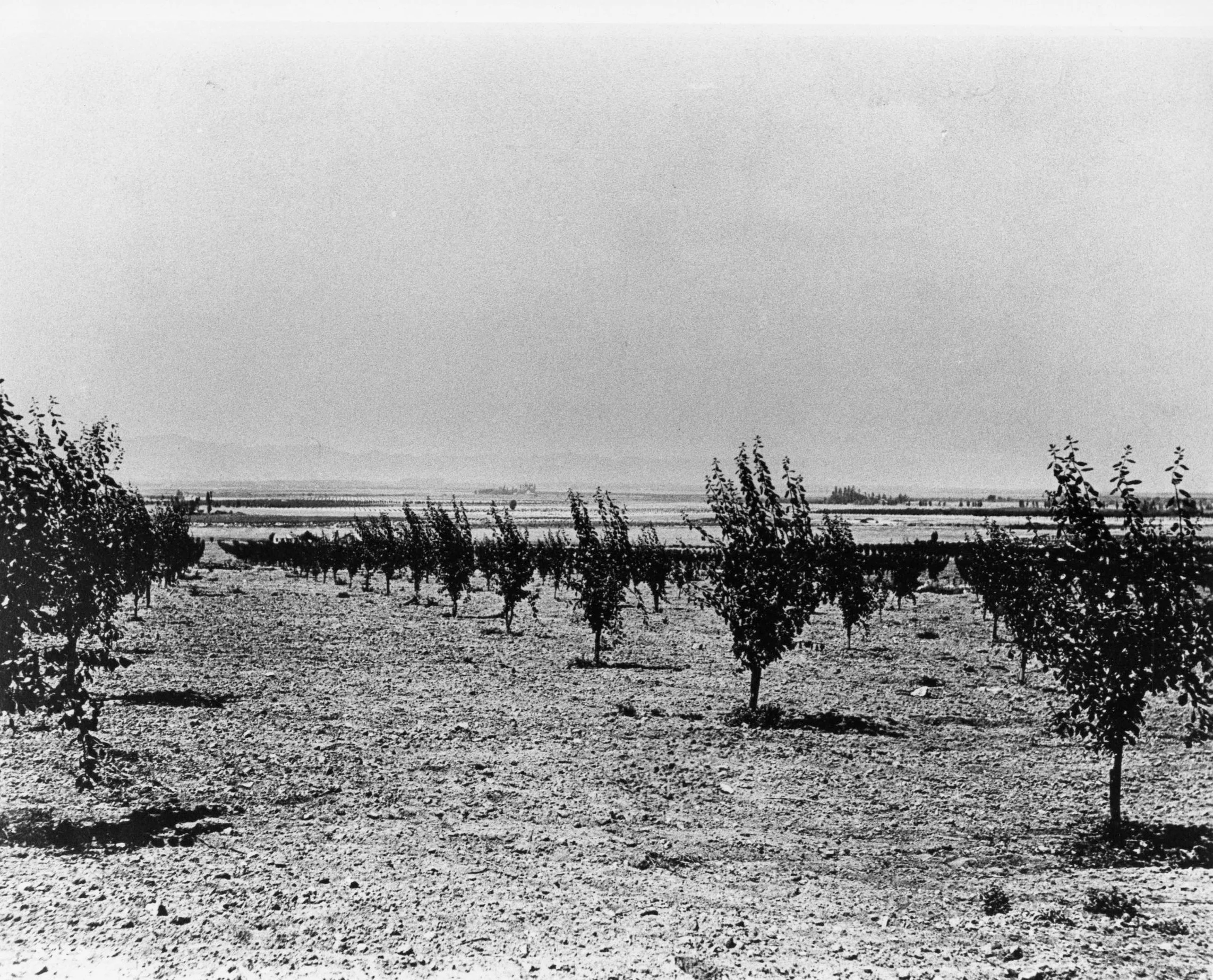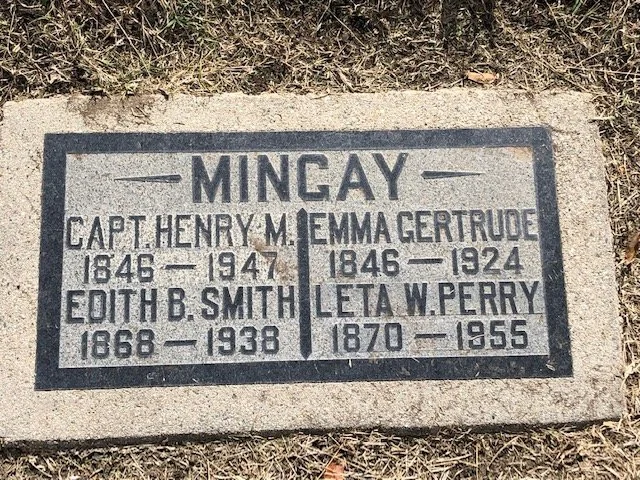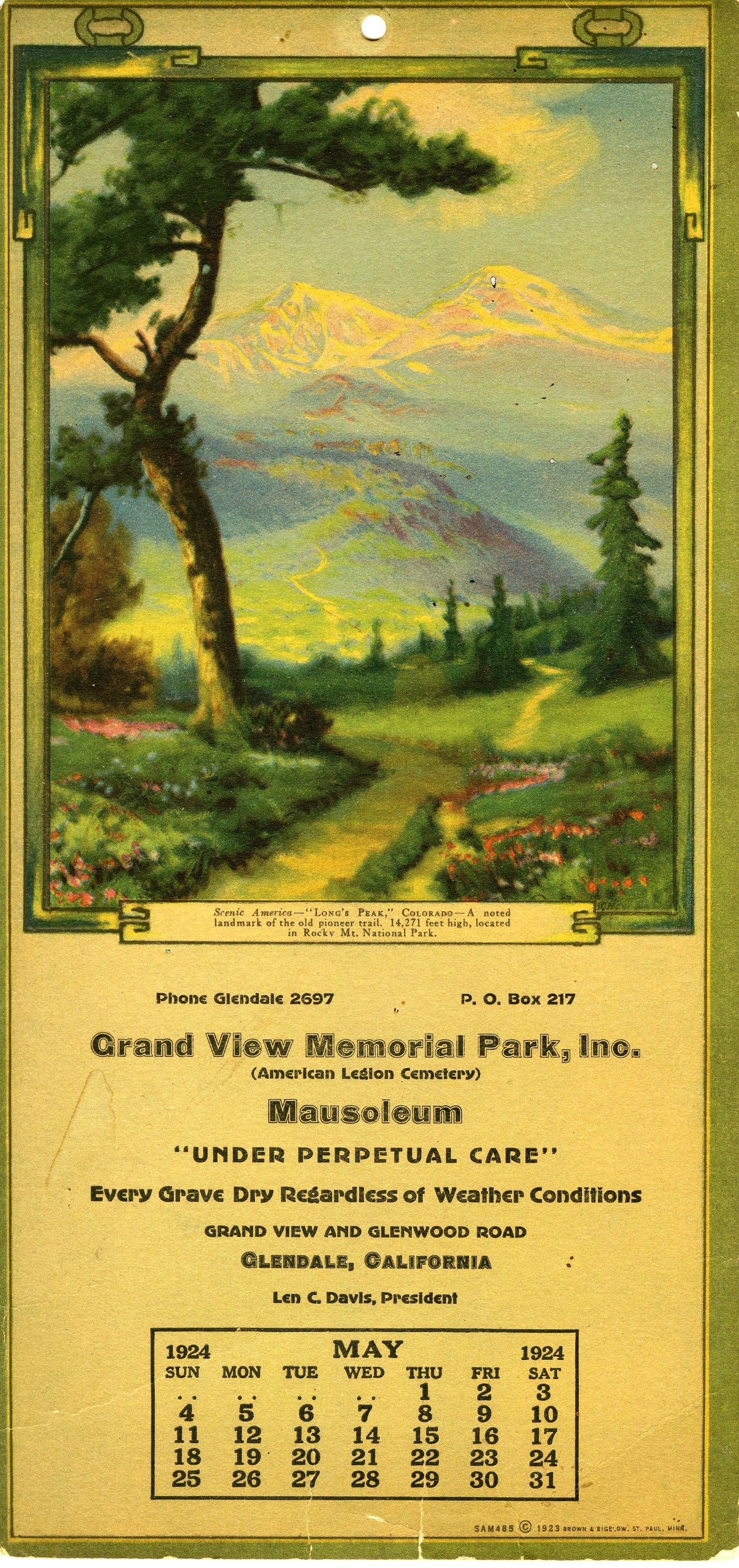STILL STANDING AFTER ALL THESE YEARS
Part V: Grandview Avenue, Grand View School and Grand View Cemetery, 1880s
By Katherine Peters Yamada
View taken from Burbank area, looking towards Glendale, 1909. Credit: Glendale History Room
Grandview Avenue begins below San Fernando Road in Northwest Glendale. It crosses Glenoaks Boulevard, ending at the entrance to Brand Park. It is possible that the street name was inspired by the expansive view from the hillside acreage which later became L.C. Brand’s estate, ‘El Miradero.’
However, Brand didn’t purchase that land until the early 1900s, and, even though Grandview Avenue doesn’t seem to appear in City of Glendale documents before 1921, the name does show up on City of Burbank maps as early as 1887.
That’s the year that Burbank’s town leaders laid out their plat map. The plat extended from the top ridge of the Verdugo Hills on the east to what is now Clybourn Avenue on the west and from what is now Burbank Boulevard on the north all the way to Grandview Avenue on the south, as described on the City of Burbank’s Citywide Historic Context Report.
Several large orchards and farmhouses dotted the area around Grandview Avenue at the time. The budding town of Glendale, which also filed its plat map in 1887, was some distance away, as Central Avenue was then our westernmost border.
Students in the Grandview area attended Burbank Grammar School, which opened that same pivotal year near San Fernando Road and Magnolia. Students also came from Roscoe (now Sun Valley), and the present Warner Brothers area. After ‘El Miradero’ was built, the children living on the Brand estate also went to school there.
Not only that, when residential telephone systems were installed, the Grandview area was in the Burbank telephone exchange.
When Burbank incorporated in 1911, the land between Alameda and Grandview avenues was inadvertently left off their official papers. Glendale annexed the area later that same year.
An elementary school named Grand View (note variation in spelling) opened in the 1920s near Grandview Avenue. The school was located at what is now Fifth and Ruberta. Now, local students could attend school closer to home.
Hundreds of Civil War Veterans Relocate to this Area
When the Civil War drew to a close, many veterans of that conflict moved west, hoping to start a new life here in California.
Wanting to maintain the connections and friendships they had forged during the war, they joined organizations such as the Grand Army of the Republic (GAR). By 1890, there were over 400,000 members across the nation.
Local units were called posts and, at one point, there were more than 8,000. They were often named for a fallen veteran.
Glendale’s post, formed in 1894, honored Union general, N.P. Banks. (See Chapter II for a photo of the building where the GAR met. It still stands on Glendale Avenue.)
Henry Mingay, originally from Saratoga Springs, New York, fought for the Union forces and was one of those veterans who came West and joined the Glendale post. Mingay was very proud of his involvement in the war and was active in the chapter, eventually becoming commander. At one point, the post had more than 100 members.
The GAR was one of the first groups to observe Decoration Day. In 1868, not long after the war was over, local posts were directed to honor the sacrifices of their fallen comrades on May 30th.
In his later years, as what is now known as Memorial Day approached, Mingay made the rounds of local schools. He gave a short, very patriotic speech telling the story of veterans of wars, specifically of those lost during the Civil War.
Grand View Cemetery
Mingay grave marker. Credit KPYamada
There were very few burial grounds in this area when the Civil War veterans arrived. Grand View Cemetery, which opened in the mid-1880s, was one of the first; many veterans were buried there. (Forest Lawn opened in 1906.)
Mingay, who died in 1947, shortly after his 100th birthday, is buried at what was by then known as Grand View Memorial Park.
Verdugo Views, Katherine Yamada, May 15, 2011 and August 25, 2018
Another Civil War Connection
Alice Humiston’s grave. Credit: KPYamada
In 1863, the body of a Union soldier - - with a photograph of three small children still in his hands - - was found on the Gettysburg battlefield. The young daughter of a local tavern keeper came upon the scene and took the photograph to her father. It became the talk of the tavern.
Several days later, a group of men who had come to help the wounded, stopped at the tavern, heard the story and saw the photograph. One of the men, a physician, offered to help find the man’s family.
He took the photo with him, had hundreds of copies made and distributed and also contacted his local newspaper, which published the story and the photo. It was reprinted in many papers and within a few weeks, one of the papers reached Philinda Humiston in Portville, New York.
She had sent the photograph to her husband, Sergeant Amos Humiston of the 154th New York Volunteer Infantry Regiment, but had not heard from him since the Battle of Gettysburg.
One of the three children, Alice, who was six years old when her father died, later moved to Glendale to live with her niece, who worked in the UCLA library.
Alice Humiston died at age 76 in 1933 and was laid to rest at Grand View. Her niece and namesake, who retired as UCLA’s head librarian, shares the same gravestone.
Katherine Yamada, Verdugo Views, June 3, 2017
Grand View Elementary Was Renamed to Honor Thomas Jefferson
Jefferson Elementary. Credit: KPYamada, 2022
During the twenties, when many schools were being renamed for famous Americans, a proposal was made to change Grand View Elementary to Thomas Jefferson Elementary.
Although the proposal initially met with some sort of opposition from the Greater Northwest Improvement Association, the change was eventually approved. By 1928, the Glendale News-Press referred to a May Day celebration at Jefferson Elementary. That day, students danced around the maypole, played ballgames and watched puppet shows in the auditorium. As the event was combined with Child Health Day, they also attended PE and displayed health related exhibits.
The current school was constructed in the 1950s and was recently modernized. Some 670 students attend grades K-6; plus a state preschool is on campus.
Still Standing After All These Years
Grand View Cemetery Renamed and Expanded in the 1920s
Len C. Davis purchased the graveyard in the early 1920s, and renamed it Grand View Memorial Park. A forty-foot arch spanned the entrance on what is now Glenwood Road and Davis also constructed a residence and a chapel.
Many of the cypress trees that were on the grounds were removed and some 1000 plots were laid out. More than 800 camphor trees, along with 200 bottle trees, were then planted to shade the area.
In May, 1921, a Glendale Evening News article informed readers that Memorial Day would bring many visitors to the cemetery, including those seeking the graves of victims of World War I and those honoring the estimated 800 Grand Army veterans buried there.
The following May, Superintendent Davis took out a large ad in the same paper, extolling ‘Glendale’s Own Cemetery,’ with its chapel and well-drained plots.
Around that same time, David A. Budwig, formerly L.C. Brand’s pilot and by then with Rogers Airport at the La Brea oil fields, photographed the expanded cemetery from the company airplane. The image appeared in the Glendale Daily Press in September 1922.
Two years later, Davis took out permits for a huge mausoleum, said to be the largest in the world at the time, and estimated to cost $400,000. Many of the 5700 crypts and 2000 receptacles for ashes had been pre-purchased by the time construction began. The mausoleum, which stretched 1060 feet, provided a cemetery wall from Kenneth Road to Glenwood.
Glendale Evening News advertisement, 1922
Grand View Memorial Park, 2022. Credit: KPYamada
Aerial view, Grand View Memorial Park, 1922. Credit, Glendale History Room
1924 Calendar. Credit: Glendale History Room
Grand View Sign. Credit: Joemy Wilson
Conclusion
Several streets in the Grandview area are shown on Burbank’s 1891 Rancho Providencia and Scott tract map:
Alameda Avenue, Spanish for ‘promenade’
Mountain Street, which winds along the base of the Verdugo Mountains
Sonora Avenue, possibly a tribute to the Mexican state of Sonora
The names of some of the local streets found on the tract map were changed after Glendale annexed the area.
Laurel Avenue (now Allen Avenue)
Fourth Street (renamed Glenoaks Boulevard for the oak trees lining the eastern portion of the thoroughfare)
Crescent (now Victory Boulevard)
Vine (now Western Avenue)
Another historic thoroughfare in this area is San Fernando Road, known as the Los Angeles and San Fernando Road as far back as 1871.
Grandview Neighborhood, one of Glendale’s many such designated districts, stretches from Alameda Avenue, (our border with Burbank) to Grandview Avenue and from Kenneth Road to San Fernando Road, according to a brochure “Come Home to Glendale,” published by the City of Glendale.
Grandview Presbyterian Church and Grandview Public Library are located in the area.
References
Our local history was studied extensively by early historians, including John Calvin Sherer, who authored ‘History of Glendale and Vicinity’ in 1922. Carroll W. Parcher incorporated much of that information in `Glendale Community Book,’ published in 1957. A later version, ‘Glendale Area History,’ was published in 1974 and expanded in 1981. Unless otherwise noted, much of what is included here is from these books and from “Glendale, A Pictorial History.”
“Come Home to Glendale,” pamphlet published by City of Glendale
City of Burbank’s Citywide Historic Context Report. https://burbank.granicus.com/MetaViewer.php?view_id=2&clip_id=6557&meta_id=242624
Grand Army of the Republic https://en.wikipedia.org/wiki/Grand_Army_of_the_Republic
1975 Glendale News-Press series of articles on street names









